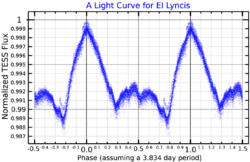Astronomy:36 Lyncis
| Observation data Equinox J2000.0]] (ICRS) | |
|---|---|
| Constellation | Lynx |
| Right ascension | 09h 13m 48.21318s[2] |
| Declination | +43° 13′ 04.1940″[2] |
| Apparent magnitude (V) | 5.30[3] |
| Characteristics | |
| Spectral type | B9IVpHgMn[4] |
| B−V color index | −0.130±0.003[3] |
| Variable type | SX Ari[5] |
| Astrometry | |
| Radial velocity (Rv) | 21.3±1.7[3] km/s |
| Proper motion (μ) | RA: –30.236[2] mas/yr Dec.: −32.032[2] mas/yr |
| Parallax (π) | 5.2687 ± 0.1577[2] mas |
| Distance | 620 ± 20 ly (190 ± 6 pc) |
| Absolute magnitude (MV) | −0.95[3] |
| Details | |
| Mass | 4.2[2] M☉ |
| Radius | 4.21[6] R☉ |
| Luminosity | 505[2] L☉ |
| Surface gravity (log g) | 3.65[7] cgs |
| Temperature | 13,700[7] K |
| Metallicity [Fe/H] | +0.60[7] dex |
| Rotation | 3.83476±0.00004 d[8] |
| Rotational velocity (v sin i) | 49±1[8] km/s |
| Other designations | |
| Database references | |
| SIMBAD | data |
36 Lyncis is a solitary[10] variable star located around 620 light years away from the Sun in the northern constellation of Lynx. It has the variable star designation of EI Lyncis, while 36 Lyncis is the Flamsteed designation. This object is visible to the naked eye as a dim, blue-white hued star with an apparent visual magnitude of 5.30.[3] It is moving further away from the Earth with a heliocentric radial velocity of 21 km/s.[3]
This is a magnetic, helium-weak Bp star[11][12] with a stellar classification of B9IVpHgMn,[4] although the spectral peculiarities have led to alternate classifications such as B8 IIImnp.[8] It is sometimes classified as a mercury-manganese star.[13] It is also an 'sn' star, displaying a spectrum with generally sharp lines for most elements in combination with broad, diffuse lines of helium.[14] 36 Lyncis has been classified as an SX Arietis variable[15] with an amplitude of 0.03 in visual magnitude and a rotationally-modulated period of 3.834 days.[5] The star is spinning with a projected rotational velocity of 49 km/s[8] and a rotation rate of 3.83476 days.[8] It has 4.21[6] times the Sun's radius and is radiating 505 times the luminosity of the Sun from its photosphere at an effective temperature of 13,700 K.[7]
References
- ↑ "MAST: Barbara A. Mikulski Archive for Space Telescopes". Space Telescope Science Institute. https://mast.stsci.edu/portal/Mashup/Clients/Mast/Portal.html.
- ↑ 2.0 2.1 2.2 2.3 2.4 2.5 2.6 Vallenari, A. et al. (2022). "Gaia Data Release 3. Summary of the content and survey properties". Astronomy & Astrophysics. doi:10.1051/0004-6361/202243940 Gaia DR3 record for this source at VizieR.
- ↑ 3.0 3.1 3.2 3.3 3.4 3.5 Anderson, E.; Francis, Ch. (2012). "XHIP: An extended hipparcos compilation". Astronomy Letters 38 (5): 331. doi:10.1134/S1063773712050015. Bibcode: 2012AstL...38..331A.
- ↑ 4.0 4.1 Abt, Helmut A.; Morrell, Nidia I. (July 1995). "The Relation between Rotational Velocities and Spectral Peculiarities among A-Type Stars". The Astrophysical Journal Supplement Series 99: 135. doi:10.1086/192182. ISSN 0067-0049. Bibcode: 1995ApJS...99..135A.
- ↑ 5.0 5.1 Samus, N. N. et al. (2017). "General Catalogue of Variable Stars". Astronomy Reports. 5.1 61 (1): 80–88. doi:10.1134/S1063772917010085. Bibcode: 2017ARep...61...80S.
- ↑ 6.0 6.1 Shulyak, D. et al. (2014). "Interferometry of chemically peculiar stars: Theoretical predictions versus modern observing facilities". Monthly Notices of the Royal Astronomical Society 443 (2): 1629. doi:10.1093/mnras/stu1259. Bibcode: 2014MNRAS.443.1629S.
- ↑ 7.0 7.1 7.2 7.3 Ghazaryan, S. et al. (November 2018). "New catalogue of chemically peculiar stars, and statistical analysis". Monthly Notices of the Royal Astronomical Society 480 (3): 2953–2962. doi:10.1093/mnras/sty1912. Bibcode: 2018MNRAS.480.2953G.
- ↑ 8.0 8.1 8.2 8.3 8.4 Cowley, A. (November 1972). "Spectral classification of the bright B8 stars". Astronomical Journal 77: 750–755. doi:10.1086/111348. Bibcode: 1972AJ.....77..750C.
- ↑ "36 Lyncis". SIMBAD. Centre de données astronomiques de Strasbourg. http://simbad.u-strasbg.fr/simbad/sim-basic?Ident=36+Lyncis.
- ↑ Eggleton, P. P.; Tokovinin, A. A. (September 2008). "A catalogue of multiplicity among bright stellar systems". Monthly Notices of the Royal Astronomical Society 389 (2): 869–879. doi:10.1111/j.1365-2966.2008.13596.x. Bibcode: 2008MNRAS.389..869E.
- ↑ Oksala, M. E.; Silvester, J.; Kochukhov, O.; Neiner, C.; Wade, G. A.; MiMeS Collaboration (January 2018). "Mixed poloidal-toroidal magnetic configuration and surface abundance distributions of the Bp star 36 Lyn". Monthly Notices of the Royal Astronomical Society 473 (3): 3367–3376. doi:10.1093/mnras/stx2487. Bibcode: 2018MNRAS.473.3367O.
- ↑ Adelman, Saul J. (May 2000). "UVBY photometry of the magnetic CP stars HD 36668, 36 Lyncis, HD 86592, and HR 8861". Astronomy and Astrophysics 357: 548–552. Bibcode: 2000A&A...357..548A.
- ↑ Ghazaryan, S.; Alecian, G.; Hakobyan, A. A. (2018). "New catalogue of chemically peculiar stars, and statistical analysis". Monthly Notices of the Royal Astronomical Society 480 (3): 2953–2962. doi:10.1093/mnras/sty1912. Bibcode: 2018MNRAS.480.2953G.
- ↑ Shore, Steven N. et al. (September 1987). "The SN Stars: Magnetically Controlled Stellar Winds Among the Helium-Weak Stars". Astronomical Journal 94: 737. doi:10.1086/114512. Bibcode: 1987AJ.....94..737S.
- ↑ Watson, Christopher (4 January 2010). "EI Lyncis". AAVSO Website. American Association of Variable Star Observers. http://www.aavso.org/vsx/index.php?view=detail.top&oid=136468.
 |


